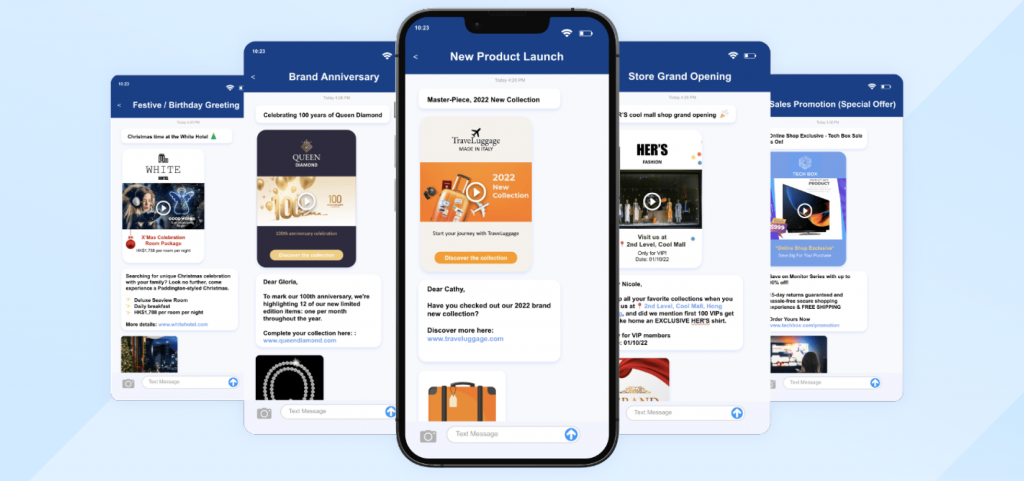
RCS has seen rapid and widespread adoption among smartphone users worldwide. It currently bridges the gap between traditional SMS and feature-rich instant messaging apps, providing users with a more interactive, expressive, and versatile messaging experience.
This article will guide you through the fascinating world of RCS messaging, uncovering its key features, benefits, and impact on transforming our everyday communication experiences.
What is RCS messaging?
RCS (Rich Communication Services) is a messaging protocol and technology designed to enhance and modernize traditional SMS (Short Message Service) messaging.
It is an evolution of standard text messaging that aims to provide a more feature-rich and interactive messaging experience, similar to popular instant messaging apps like WhatsApp, iMessage, and Telegram.
RCS allows users to send multimedia content such as high-quality images, videos, audio messages, and files, as well as utilize read receipts, typing indicators, and group chats.
It supports advanced features like real-time video calling, location sharing, and integration with other services. RCS is intended to be compatible across different devices and operating systems, making it a universal and interoperable messaging platform.
Importance and relevance of RCS in modern communication
RCS aims to work across various devices and operating systems without the need for specific apps or accounts, making it more accessible to a broader audience.
It is built into the carrier’s network, so it doesn’t rely on internet connectivity like many other messaging apps. This can be crucial in areas with limited internet access or during network outages.
RCS is also designed with security in mind, offering end-to-end encryption for secure communication. As a result, users can feel more confident that their messages and data are protected.
RCS messaging holds great importance and relevance in modern communication due to its ability to enrich traditional SMS with multimedia capabilities, improved features, and enhanced security.
Key features and functionalities of RCS messaging
Here are some of the most important characteristics of RCS messaging:
- RCS allows multimedia messaging and enables users to create group chats or even make video calls.
- It supports real-time location sharing, allowing users to share their current location with contacts.
- RCS can integrate with various services, such as chatbots, payment systems, and business messaging, enhancing user experiences.
- RCS allows the creation of interactive cards and carousels within messages, providing users with engaging content that can be scrolled through horizontally. These interactive elements enable businesses to showcase products, offer recommendations, and provide more interactive experiences within the messaging app.
- Some RCS implementations include support for secure in-app payments, allowing users to make transactions directly within the messaging app, enhancing the convenience of peer-to-peer payments and interactions with businesses.
Advantages of RCS over traditional SMS
This is why RCS is continuing to gain popularity while more traditional communication methods are left behind:
- RCS provides a more engaging and dynamic messaging experience compared to plain text in traditional SMS.
- With RCS, users gain access to features like read receipts, typing indicators, group chats, and video calling, which are absent in standard SMS.
- It is designed to work across different devices and operating systems, unlike some proprietary messaging apps, making it more universally accessible.
- Since RCS is integrated into the phone’s messaging app, users do not need to install separate apps for enhanced messaging features.
- RCS is built into the carrier’s network, ensuring that users can utilize its functionalities even without internet access.
Who is adopting RCS?
Businesses across the mobile industry and beyond support RCS because of its potential. Ultimately, the main reason RCS is growing in popularity is because of the evolution of conversational marketing. Crucially, RCS claims to streamline the vast array of IM apps on the market.
Current status of RCS implementation worldwide
RCS implementation has steadily grown worldwide, with many telecommunication carriers and tech companies actively embracing it.
During Google I/O 2023, it was announced that the number of monthly RCS users had surpassed 800 million, indicating widespread adoption and familiarity among many Android users.
Google, in particular, has played a significant role in promoting RCS by integrating it into the Android Messages app, which comes pre-installed on many Android devices.
Carriers and devices supporting RCS messaging
Numerous telecommunication carriers worldwide have adopted RCS and offer support for their subscribers. Some major carriers include:
- Verizon (USA)
- AT&T (USA)
- T-Mobile (USA)
- Vodafone (multiple countries)
- Orange (multiple countries)
- Deutsche Telekom (Germany)
- Telefonica (Spain and Latin America)
- Airtel (India)
- Globe Telecom (Philippines)
In terms of devices, many Android smartphones come with native support for RCS through the default messaging app, especially those from Google’s Pixel series and other major manufacturers like Samsung, LG, and OnePlus.
Challenges and barriers to widespread RCS adoption
The lack of a unified RCS implementation across all carriers and devices has been a significant challenge. Some carriers use their own proprietary RCS solutions, which can lead to interoperability issues and a fragmented user experience.
While RCS does not require internet connectivity like OTT apps, some carriers limit RCS functionality when users are on a data connection, preferring to prioritize their own data-based messaging services.
How to use RCS on your phone
RCS relies on a cloud-based infrastructure that enables the exchange of messages between users. Unlike SMS, which is a peer-to-peer communication, RCS messages are transmitted through servers operated by mobile carriers or third-party RCS providers. This cloud-based architecture allows for improved multimedia capabilities and a more seamless user experience.
To use RCS, your mobile carrier needs to support the protocol and have it integrated into their network. Many major carriers worldwide have adopted RCS, but it’s essential to check if your carrier supports it. Additionally, your device must also be RCS compatible. Most modern smartphones are RCS-capable, but some older or entry-level devices may not support it.
RCS offers a range of multimedia capabilities, allowing users to send high-quality images, videos, and audio messages without the limitations of traditional MMS. Moreover, RCS supports read receipts, typing indicators, and group messaging, making it similar to instant messaging apps. Users can also send and receive messages over Wi-Fi or data, bypassing the need for cellular coverage.
To check if your phone supports RCS, follow these general steps (specific steps may vary depending on your device and carrier):
- Go to your phone’s settings.
- Look for an option related to “Advanced Messaging” or “Chat features.”
- Enable the toggle or switch for RCS or Chat features.
- If prompted, follow the on-screen instructions to set up RCS.
If your carrier and device support RCS, you should now be able to use it for enhanced messaging experiences with other RCS-capable contacts, enjoying features like read receipts, high-quality media sharing, and more interactive conversations.
If RCS is not available on your carrier or device, you can still use traditional SMS/MMS for regular messaging.
How to enable RCS on Android
First, you need to check if your mobile carrier supports RCS. If it does, follow these steps to enable it on your Android device:
- Open the Google Messages app (you can download it from the Play Store if it’s not pre-installed).
- Go to Settings > Chat features.
- Toggle on Enable chat features. This will enable RCS, allowing you to send messages over Wi-Fi or mobile data, share larger files, and see read receipts or typing indicators.
- Follow the setup prompts to complete the configuration.
Once activated, you can start using RCS for messaging with contacts who also have it enabled. Your conversation bubbles may appear blue, similar to iMessage, when using RCS.
How to enable RCS on iOS
On September 17, 2024, Apple announced the launch of Rich Communication Services (RCS) support with the release of iOS 18. This development represents a major leap in the evolution of messaging, the result of years of collaboration between mobile carriers, device manufacturers, and technology providers.
With this update, Apple brings feature-rich RCS messaging to more users, enhancing communication across both iOS and Android platforms.
If your carrier supports RCS, follow these steps to ensure it’s activated on your iPhone:
- Go to Settings.
- Scroll down and tap on Apps.
- Select Messages.
- Under Text Messaging, tap RCS Messaging.
- Toggle the switch next to RCS Messaging to enable it.
Key features of RCS messaging
- Rich media sharing: photos, videos, audio, file attachments, etc.
Unlike traditional SMS, which often compresses media files and reduces their quality, RCS maintains the original resolution and fidelity, providing a more immersive and enjoyable messaging experience.
- Read receipts and typing indicators
Typing indicators let participants know when someone is currently composing a message, adding real-time visibility to conversations and reducing the uncertainty of message delivery and response.
- Group messaging and chat functionalities
It enables seamless group messaging with options to name groups, add or remove participants, and view the list of group members. Group chats support multimedia sharing and other RCS features, making group interactions more dynamic and interactive.
- Advanced messaging options: Enhanced emojis, stickers, and reactions
The expanded emoji collection includes animated emojis, while stickers and reactions provide fun and visual ways to react to messages, enhancing the emotional depth of interactions.
RCS business messaging
Here is how RCS is reshaping customer communication and opening new doors for businesses to thrive in the digital age.
RCS in customer engagement and marketing campaigns
Unlike traditional SMS, RCS supports rich media, such as high-quality images, videos, carousels, and interactive buttons, enabling businesses to showcase products, services, and promotions in a more engaging manner. This enhanced visual presentation can significantly impact customers’ interest and response rates.
Use cases for businesses and brands to leverage RCS
- Customer support: RCS can be utilized as a customer support channel, enabling real-time interactions, chat functionalities, and multimedia sharing to address customer queries and concerns more effectively.
- Event invitations: RCS can be used for sending event invitations with interactive buttons for RSVPs, event details, and multimedia content to create excitement and anticipation.
- Personalized offers and promotions: With RCS, businesses can deliver personalized offers and promotions based on customer preferences and behavior, increasing the likelihood of conversion.
- Order status and delivery updates: RCS can provide real-time updates on order statuses, delivery tracking, and estimated arrival times, enhancing transparency and customer satisfaction.
- Product catalogs: Businesses can use RCS to share product catalogs with customers, showcasing their offerings with images, videos, and descriptions. Customers can explore products directly within the messaging app.

Privacy and security considerations
Let’s delve into the key privacy and security considerations associated with RCS messaging, exploring how service providers and users can navigate this advanced communication landscape while ensuring confidentiality and protecting sensitive data.
Data protection and user privacy in RCS messaging
Service providers must consider encrypting messages both in transit and at rest, ensuring that only authorized parties can access message content.
Compliance with privacy regulations and best practices
Service providers and carriers offering RCS messaging services must adhere to relevant privacy regulations, such as the General Data Protection Regulation (GDPR) in Europe or the California Consumer Privacy Act (CCPA) in the United States. They should also follow industry best practices for data handling, storage, and sharing, obtaining explicit user consent for data processing, and adhering to users’ preferences regarding message visibility and retention.
Ensuring secure and confidential messaging experiences
RCS messaging platforms need to implement end-to-end encryption to protect the content of messages from being intercepted or accessed by unauthorized parties. Additionally, secure authentication mechanisms should be employed to prevent unauthorized access to users’ RCS accounts.
Future prospects and innovations
Here is where we explore the exciting possibilities that lie ahead for RCS, from potential new features to evolving business applications, and how this transformative technology is poised to shape the future of digital communication.
Predictions for the future of RCS messaging
As major smartphone manufacturers, carriers, and tech companies continue to support RCS, its global adoption is likely to increase significantly. This could lead to RCS becoming the default messaging platform on a wide range of devices.
In the future, RCS may become more compatible across different messaging platforms. This could enable seamless communication between RCS users and users of other popular messaging apps, reducing fragmentation and improving interoperability.
Additionally, the potential integration of advanced features, such as AI-powered chatbots and enhanced multimedia sharing, could further propel RCS’s popularity and utility. As RCS evolves, businesses may find innovative ways to leverage its capabilities for customer engagement, personalized marketing, and streamlined communication workflows.
The ongoing development and refinement of RCS standards and technologies will play a pivotal role in shaping its future trajectory and determining whether it can truly become the next evolution of messaging for a diverse and interconnected digital world.
Impact of RCS on the future of mobile communication
With RCS offering rich features and cross-platform compatibility, it may lead to the consolidation of messaging services, reducing the need for users to rely on multiple messaging apps.
Traditional SMS usage may decline as users opt for the more feature-rich and interactive experience RCS messaging offers.
RCS could pose a significant challenge to Over-the-Top (OTT) messaging apps like WhatsApp and Facebook Messenger. RCS’s widespread integration and features may lead users to choose RCS as their default messaging platform.
It may become an integral part of larger ecosystems, with features like payment services, social media integration, and more, making it a versatile platform for various needs.
with Textmagic!
Conclusion
The potential for richer, more immersive conversations awaits as RCS paves the way for a transformative messaging experience.
When exploring the possibilities of RCS messaging for your personal or business needs, choosing a reliable and innovative communication solution is essential.
While RCS messaging brings forward a new era of messaging experiences, Textmagic provides a comprehensive suite of features that can easily compete with RCS in several aspects.
It is worth mentioning that, unlike some messaging systems that rely on specific phone operating systems, Textmagic transcends these limitations. Our user-friendly application is designed to be compatible with a wide array of devices and accessible across all popular browsers and mobile operating systems.
Visit our website to experience Textmagic’s potential and revolutionize your communications. Unlock a world of possibilities in messaging excellence.
Related articles
How to calculate customer health score and slash churn rates
Customer health scores are metrics that reduce custo...
10 Ecommerce SMS templates to help you sell by text
Texts adverts and promotions represent an excellent ...
10 Ways to improve your business text message writing
Crafting a strong message is a lot harder than it lo...
How to use text messaging for your wedding planning business
As a wedding planner, your job is to eliminate the s...
How to create a loyalty program customers will love
Fostering customer loyalty nowadays involves more th...




